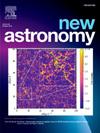利用机器学习从重子参数预测暗物质亚halos的物理特性
IF 1.9
4区 物理与天体物理
Q2 ASTRONOMY & ASTROPHYSICS
引用次数: 0
摘要
暗物质亚halos 在星系形成和演化过程中发挥着重要作用。然而,准确预测暗物质特性仍然是现代天文学面临的一项挑战。近来,机器学习(ML)工具在解决众多天体物理问题方面取得了可喜的成果。在本文中,我们利用来自 EAGLE 模拟的数据,使用梯度提升决策树(GBDT)和密集神经网络,利用气体、恒星、黑洞的结构特性和光度特征来确定暗物质亚halos 的总质量和半质量半径。GBDT 不需要数据预处理,与神经网络相比性能更好。根据梯度提升决策树,估计子晕半径和质量的最重要特征分别是气体半径和黑洞质量。结合所有特征的方法获得了最高的测试精度--对于半径和质量,皮尔逊相关系数分别为 0.947 和 0.981,判定系数分别为 0.898 和 0.962,归一化中位绝对偏差分别为 0.111 和 0.114。我们对超出训练范围的质量和红移模型进行了评估,发现 GBDT 的外推能力明显优于神经网络。我们还在不同分辨率的模拟中测试了我们的模型,发现如果改变分辨率,差异在 10%以内。这项新颖的研究结合了气体和黑洞的结构参数,利用基于 ML 的方法确定了暗物质的属性。这项研究的良好结果证明,ML 工具可以改善我们目前对暗物质的理解,并回答一些基本的宇宙学问题。本文章由计算机程序翻译,如有差异,请以英文原文为准。
Predicting the Physical Properties of Dark Matter Subhalos from Baryonic Parameters Using Machine Learning
Dark matter subhalos play an important role in galaxy formation and evolution. However, accurate prediction of dark matter properties remains a challenge of modern-day astronomy. In recent times, machine learning (ML) tools have shown promising results in solving numerous astrophysical problems. In this paper, we use data from the EAGLE simulations to determine the total mass and the half-mass radius of dark matter subhalos using structural properties of gas, star, black hole, and photometric features using gradient boosted decision trees (GBDT) and dense neural network. GBDT does not require data preprocessing, and results in better performance compared to the neural network. According to GBDT, the most important feature for subhalo radius and mass estimation is gas radius and black hole mass respectively. The all-features combined approach results in the highest test accuracy — Pearson’s correlation coefficient = 0.947 and 0.981, coefficient of determination = 0.898 and 0.962, normalized median absolute deviation = 0.111 and 0.114 for radius and mass respectively. We evaluate our model for masses and redshifts beyond its training range and find that GBDT demonstrates significantly better extrapolation capabilities than the neural network. We also test our model on simulations with different resolutions, and find that the discrepancies lie within 10% if the resolution is changed. This novel study incorporates the structural parameters of gas and black hole to determine the dark matter properties using a ML-based approach. The promising results of this study prove that ML tools can improve our current understanding of dark matter, and answer some of the basic cosmological questions.
求助全文
通过发布文献求助,成功后即可免费获取论文全文。
去求助
来源期刊

New Astronomy
地学天文-天文与天体物理
CiteScore
4.00
自引率
10.00%
发文量
109
审稿时长
13.6 weeks
期刊介绍:
New Astronomy publishes articles in all fields of astronomy and astrophysics, with a particular focus on computational astronomy: mathematical and astronomy techniques and methodology, simulations, modelling and numerical results and computational techniques in instrumentation.
New Astronomy includes full length research articles and review articles. The journal covers solar, stellar, galactic and extragalactic astronomy and astrophysics. It reports on original research in all wavelength bands, ranging from radio to gamma-ray.
 求助内容:
求助内容: 应助结果提醒方式:
应助结果提醒方式:


